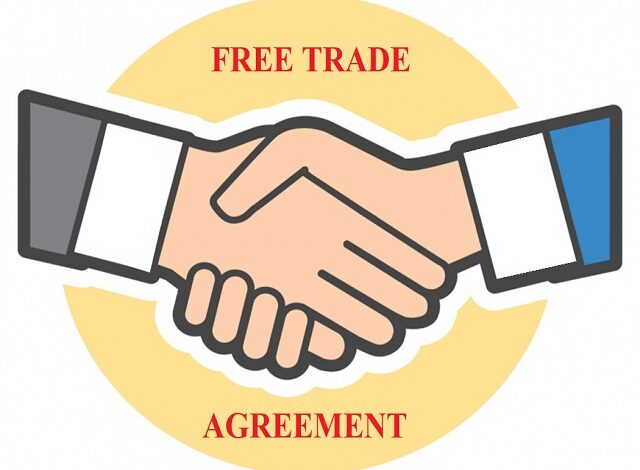How India should handle sustainable development challenges in trade talks is the subject of a new negotiating agenda in 2022.

There is a growing trend among developed countries to include provisions in Free Trade Agreements (FTAs) that link Trade and sustainable development (TSD) (FTAs). TSD provisions are included in nearly all the free trade agreements (FTAs) recently concluded by the United States and the European Union.
Most TSD provisions in free trade agreements (FTAs) deal with environmental and labour protection issues. These, in turn, are predicated primarily on Multilateral Environmental Agreements (MEAs) and International Labor Organization (ILO) conventions, as well as other international treaties and agreements.
There is no doubt that Trade can be a critical facilitator of sustainable development in several ways. However, when it comes to adopting enforceable standards at the bilateral or multilateral fora, most developing nations equate this connection of TSD (part of the more problematic “trade and…” concerns at the World Trade Organisation) to the opening of a pandora’s box of trade protectionism.
It is feared by developing countries that TSD obligations will lead to trade restrictions being implemented by developed countries based on a stringent definition of sustainability. Such strict labour and environmental regulations are divorced from the dire socioeconomic realities of developing countries, and as a result, they unfairly penalize them in the long run. How could India, a nation with more than 134 million people living on less than $2 a day, guarantee labour norms that are frequently not reached by the world’s most excellent economy?
These concerns were expressed by CUTS International in its Third World Intellectuals and NGOs’ Statement Against Linkages (TWIN-SAL) in 1999, which demanded that, rather than attempting to kill two birds with one stone, the international community should try to kill one bird with another. Although protecting the environment and workers’ rights are essential goals for countries to pursue on their own, there are specialized multilateral and regional institutions to which developing countries can (and do) contribute as active participants. As a result, these “trade and…” discussions are, at best, excessive, and at worst, attempt to legitimize trade protectionism through the use of statistics.
Further, the best strategy to attain higher environment/labour standards is through export-based growth and economic development. Redirecting the gains from trade liberalization would meet the same objectives these ‘social clauses’ sought, but in a just manner.

Regardless of the legitimacy of these arguments, new economic and political realities cannot be denied.
First, India is engaged in FTA negotiations with important and developed trade partners that significantly emphasize TSD chapters. As a country focused on export-led growth, it should brace itself for some challenging quid pro quos.
Second, India herself has very ambitious domestic and international commitments on these issues. In so far as Trade is a common thread that can connect different spheres of global governance and facilitate greater synergy, India should try to formulate rules that complement her efforts to attain sustainability.
Third, India can attempt to utilize bilateral and regional fora to test its comfort with TSD linkages in a limited setting without changing India’s position on keeping environment and labour outside the WTO’s negotiating agenda.
This article will first discuss why India may have to address TSD in FTA negotiations and how such engagement could prove to be a winning (though challenging) proposition. Consequently, this article will broach how India could negotiate TSD clauses that serve multiple purposes – enabling India to reach its ambitious sustainability objectives while safeguarding market access from protectionism and buffering the inevitable short-term losses incurred during the period of adjustment.
The Inevitable Tide: rise and rise of TSD clauses in FTAs
The gradual and consistent acceptance of TSD clauses in trade agreements, especially mega-regionals like the Comprehensive and Progressive Agreement for Trans-Pacific Partnership (CPTPP) and the resolve in the Indo-Pacific Strategy of the US to “develop new approaches to trade that meet high labour and environmental standards” implies that sooner or later, most developing countries in the Asia-Pacific will undertake or be impacted by commitments on labour rights and environmental protection.
Accordingly, if India desires to integrate itself into global value chains and the new trading order driven by a critical mass of countries, a discussion on TSD clauses in FTAs will become non-negotiable. Case in point, the ratification of the EU-MERCOSUR trade deal has been put on hold (after twenty years of negotiations) due to pressure from businesses, civil society, and some EU member states over the agreement’s failure to include guarantees on sustainability.
Second, growing public consciousness and changes in consumer preference are increasingly creating an incentive to enter a ‘race to the top and distinguish products from competitors based on adherence to social values rather than cost differential alone. Thus, domestic exporters will inevitably need to upgrade their products and processes per increasingly higher environmental/labour product standards and labelling measures in developed countries.
Acceding to incremental TSD obligations for greater market access could help incentivize exporters to comply with its provisions to avail the FTA’s benefits. This would differentiate Indian exporters from competitors, as has been tried by prominent players in the textile and leather sectors. Nationally, India has adopted various public and private labels like the Ecomark (for consumer products meeting fixed environmental criteria) and RUGMARK (addressing child labour in the rug-making industry), and there should be a push for greater uptake of the same.
Beyond immediately real commercial prospects, the ongoing geopolitical, geo-economic and geo-technological churn will see global challenges that necessitate the existence of reliable and sustainable supply chains. India must build itself to be “an engine for regional growth and development.”
Third, with or without TSD obligations in FTAs, there is a rise in the number of trade measures being taken to address SD goals. Various international legislations focus on sustainability and impact supply chains. For instance, Section 307 of the US Tariff Act prohibits importing products manufactured wholly or in part by forced labour, including forced child labour. The Australian Modern Slavery Act of 2018 requires companies to report steps taken to keep their supply chains free of modern slavery.
Fears of protectionism through new non-tariff measures in developed countries can be addressed through WTO-plus rules negotiated bilaterally/within lighter blocs if India assents to engage in meaningful talks on these issues.
Fourth, considering the growing momentum of negotiations at the WTO (multilateral rules on fisheries as well as a plurilateral push for Trade and Environmental Sustainability Structured Discussions, restrictions on plastics trade and phasing out of fossil fuel subsidies), FTAs can allow India to dip her toes in the waters of TSD. Utilizing this experience at the regional and bilateral levels, particularly with some of the rich demandeur countries, will allow India to address these issues at the WTO with greater ease.
Finally, and perhaps most importantly, India needs a new negotiating agenda that targets simultaneous transformation on two fronts. First, in pursuit of economic growth, India needs to necessarily attain competitiveness in manufacturing and eliminate trade barriers in key export markets. Second, while bucking all trends, India must strive hard for a low-carbon pathway to such economic growth. The right mix of policies with an adequate focus on green goods, services and technologies can accelerate India’s movement along its economic and environmental Kuznets curves to reduce inequality and ecological degradation.
Shifting the Indian workforce from low productivity, highly polluting and informal ventures to resource-efficient manufacturing that is sustainable and formal will require the negotiation of conducive trade deals in synergy with its domestic reforms.

Dip Toes, Don’t Tiptoe: essential items to check in the new sustainable negotiating agenda
With sights on an ambitious developmental model that bucks previous trends of ‘growing up and cleaning up, the new schedule should be built on three prongs.
An ambitious yet practical TSD chapter
First, the FTA must take on a suitable level of legal obligations that India can deliver.
Negotiators must ensure that India does not repeat its past mistake of overpromising and underdelivering as it did with its International Investment Agreements. The aftermath resulted in back-to-back defeats in Investor-State Dispute Settlement (ISDS) litigation.
Accordingly, India could style its TSD chapters like those in the US FTA with CAFTA or the EU FTA with Vietnam, which base their demands on agreements signed under the auspices of the MEA/ILO in promotional language, rather than binding or conditional conditions. Notably, when it comes to the enforcement of environmental/labour norms, India should consent to terms that pay sufficient attention to ‘domestic circumstances’ while implementing basic labour or environmental requirements (Art 13.4(3)(b), EU-Vietnam FTA).
India could also opt for sections where the adequacy of domestic legislation to reach a higher level of standards is allowed to discretion. Following Article 285 of the EU Central America Association Agreement, For example, India’s agreement to “phasing down” rather than “phasing out” the use of coal balances her commitment to become carbon-neutral by 2070 while retaining the right to supply inexpensive energy to meet the requirements of its industrialization and urbanization. As a result, even if one of the parties considers that India’s domestic framework provides only a modest degree of protection, as long as the framework is successfully executed, there should be no violation of the TSD requirements.
In addition, India should insist on making the TSD chapter an incentive rather than a sanction-focused chapter, as previously stated (more carrots, fewer sticks). Positive incentives were used to bring about regulatory convergence in the United States-Cambodia Textile Agreement. Increased export quotas were made available due to compliance with labour standards, establishing a relationship between higher labour standards and more substantial export possibilities and job growth. In a similar vein, an FTA between Indonesia and the European Free Trade Association gives cheaper tariffs to Indonesian palm-oil exporters, provided they adhere to specific environmental criteria and regulations.
This gets us to the second part of the argument.
Improve the way you construct your future.
If India agrees to stricter regulations and standards, it should negotiate enforceable and substantial commitments for aid and capacity development in return for its cooperation. The promises made by rich nations in other fora, such as the United Nations Framework Convention on Climate Change (UNFCCC), to promote the transfer of technology and money would be reinforced as a result of this action. India could also insist on its FTA partners playing a more significant role in the galvanization of India-led international initiatives such as the Green Grid Initiative-One Sun, One World, One Grid (GGI-OSOWOG), which is part of the International Solar Alliance and aims to connect solar grids all over the world (GGI-OSOWOG).
Even in the absence of an FTA, a slew of upcoming climate-change-fighting measures, such as the EU’s Carbon Border Adjustment Mechanism and another carbon-related border/pricing measures emerging in the United States, the United Kingdom, and Canada, will make it imperative for Indian exporters to adapt to the new environment.
Moreover, exponential growth in sustainability requirements will become necessary for India and its exporters, particularly Small and Medium-Sized Enterprises (SMEs) wishing integration with Global Value Chains to gain access to more lucrative markets. It is worth noting that many voluntary private norms are evolving into de facto or legal regulations and that this trend will continue to spread. These often need more significant performance levels and fast upgrades to keep up with changing market demands, raising the costs and difficulties of compliance, particularly for micro and small and medium-sized enterprises (SMEs).
Adjustment to such change needs financial and technical assistance, which may be provided, for example, by training people to integrate into value chains powered by green technology. The increased availability of clean technologies and financial resources to bridge the resource gap between domestic and international frameworks will result in green protectionism if the availability of clean technologies and financial resources to bridge the resource gap between domestic and international frameworks is not ensured.
There should be a strong emphasis on innovation in the Free Trade Agreement to address concerns about equal access to green products and technology via their transfer/licensing at fair and acceptable conditions. As a result of environmental standards or restrictions that influence the exports of developing nations, this is a reasonable compromise in situations when the employment of such technology is rendered unavoidable.
Increased flexibility, protections, and regulatory coherence on a broader scale
The third and final prong requires India to draught safeguards, sometimes known as “relief clauses,” for use in the TSD context.
In other words, India should be allowed to negotiate for flexibilities that take into account its socioeconomic circumstances and its citizens’ particular interests. Consider the case of India, where, despite the government’s attempts to prevent child labour, particularly in dangerous sectors, widespread poverty forces families to choose more money above other needs. Clauses in the dispute resolution chapters that consider good faith and best efforts made to resolve labour issues must be included as a result of this. Comprehensive and Progressive Agreement for Trans-Pacific Partnership (CPTPP) (Article 20.3.5, CPTPP)
An extension of the transition period might be granted to the TSD chapter to provide the domestic industry sufficient time to adapt before the execution of TSD duties becomes necessary. Another possibility is to exclude specific industries from TSD duties by establishing carveouts for such sectors (like agriculture). This might also be done in the case of particular policy initiatives that India considers essential to facilitate a “fair transition.” This will enable India to continue pursuing actions to ensure long-term sustainability without jeopardizing employment, industrialization, and urbanization aspirations (e.g., government procurement and reasonable subsidies on fossil fuel).
It is important to note that TSD infractions should not cancel benefits under the FTA. To ensure that dispute settlement concerning labour obligations remains inapplicable for a specified period (transition period) and that, even after the operation of dispute settlement, the outcome of the payment does not result in Parties suspending benefits under the Free Trade Agreement, Vietnam has negotiated side agreements with CPTPP Parties.
In fact, instead of exposing the TSD chapter to traditional dispute resolution, India might choose to use institutional processes that are relatively light on the ground to resolve the disagreement. Among them is establishing lines of communication with non-state organizations, such as labour unions. Such clauses are prevalent in the TSD chapters of EU Free Trade Agreements. Compared to state-to-state dispute resolution or fines for non-compliance with TSD requirements, this gentle approach produces significantly less animosity and is far more successful in achieving results.
Additionally, to prevent TSD duties from becoming a cloak for protectionism in developed countries, specific positive responsibilities towards reducing non-tariff barriers must be included in the agreement.

Integration of FTAs through the recognition of each other’s measures as equivalent or the adoption of a single shared standard (harmonization), as well as the reduction of unnecessary regulatory diversity (through Good Regulatory Practices), can help to remove trade barriers, lower administrative costs, and ultimately improve market competitiveness by lowering administrative costs and enhancing market competitiveness.
At the same time, the FTA might offer a systematic means of dealing with the disparity between different trade policies pursued in pursuit of similar climate-related goals. For example, even though India has not established a carbon price, several governmental programmes indirectly tax or price carbon emissions. For example, the Perform, Achieve, and Trade plan rewards and penalizes industrial sectors based on their achievement or failure to achieve government-mandated energy consumption reduction objectives. The PAT system is analogous to the European Union’s Emissions Trading System (EU ETS) (cap-and-trade). According to the authors, a possible connection between the two and the creation of a broader market for emissions trading may be achieved via the harmonization of monitoring, reporting, and verification (MRV) regulations.
Concluding Remarks
It is imperative that India’s efforts to negotiate a comprehensive set of instruments to create sustainable trade outcomes be guided by creativity and practicality. Enhanced labour and environmental protection in the local industry should be encouraged by the Indian government to secure improved developmental outcomes.
Citizens will benefit from the results. A suitably adapted TSD chapter in India’s free trade agreements (FTAs) might be a positive factor for the country, and it should not be resisted without careful deliberation.
edited and proofread by nikita sharma




